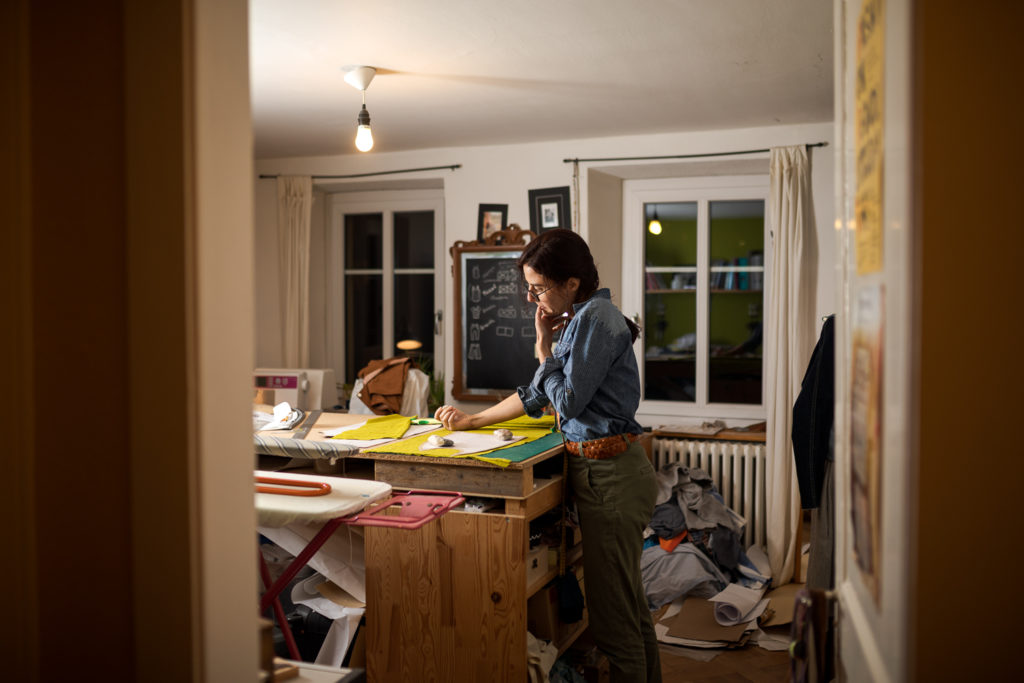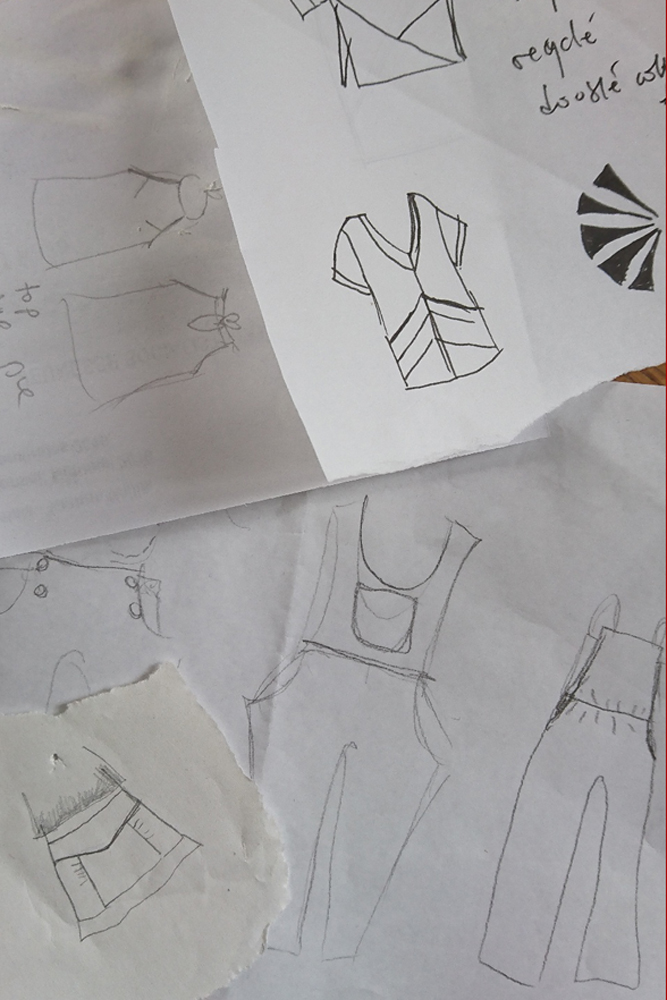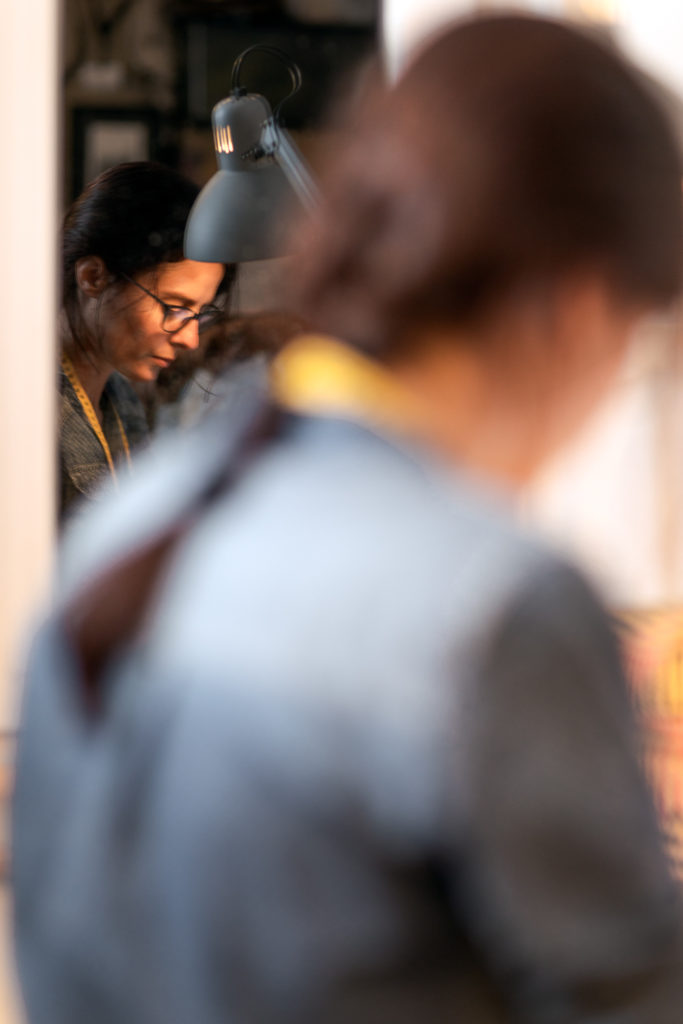Processus créatif

Deutsche Version
English version
Lorsque vous achetez un vêtement, est-ce qu’il vous arrive de penser à son histoire ? Comment a-t-il été créé ? Qui a eu l’idée et comment ? Combien de temps a-t-il fallu entre le moment où la première idée a germé et celui où ce vêtement a été réalisé ?
Cet article vous emmène dans mon atelier afin de découvrir comment naissent mes idées, comment elles prennent forme au travers d’essais et d’erreurs, de recommencements, d’abandons et de succès…

Le processus de création est composé d’une succession d’étapes complexes:
- croquis des vêtements
- sélection des idées
- patronage (plan des vêtements en deux dimensions)
- réalisation de prototypes
- corrections des patrons
- prototypes finaux
- choix/création des tissus
tem pimenta est un petit label et je réalise toutes les étapes seule et à la main, ce qui représente un défi passionnant!
L’inspiration débarque par surprise, souvent quand je suis plongée dans mes rêves, ce qui laisse la place à des associations d’idées spontanées. Cela peut m’arriver lorsque je me promène dans la nature, que je prends le train ou encore lorsque j’écoute de la musique ou regarde un film.
J’aime l’idée que ces moments où je suis inactive, non-productive, dans l’instant présent, permettent d’accueillir ces élans de créativité.
Je griffonne alors ces idées sur le premier petit bout de papier qui me tombe sous la main. Toutes ne sont pas bonnes à garder. Certaines sont irréalisables, d’autres sont du « déjà-vu », d’autres trop couteuses à réaliser… Un premier tri s’opère ainsi naturellement. Je dois faire attention à ce que ces nouvelles idées viennent s’ajuster à la collection existante et aux créations en cours. Il faut rechercher la cohérence, le rappel d’un détail d’un vêtement à l’autre, une coupe qui se ressemble, un style commun qui se dégage. C’est un équilibre à trouver entre innovation et constance afin de garantir un ensemble harmonieux.
Enfin, j’essaie de créer plusieurs types de vêtements qui pourront s’assembler. Rien ne sert d’avoir uniquement des idées de robes… il me faut aussi des hauts, des pantalons, des vestes…
(3ème photo) Credit photo: @samuel.devantery
Lorsqu’une idée me semble tenir la route et entrer dans un projet global cohérent, je me lance dans le patronage. Je commence par réaliser des dessins techniques. Pour que le vêtement soit facile à enfiler, je dois penser à l’ouverture. Je dois également réfléchir où je souhaite que l’habit soit ajusté ou au contraire, comment je vais créer des volumes.
Puis, je trace le patron sur une grande feuille. Je concrétise les aspects techniques (pinces, reports de formes, prises de mesures) avant de découper chaque pièce de patron.
Je les dépose ensuite sur le tissu (préalablement repassé) afin de procéder à la coupe. Pour les prototypes, je travaille exclusivement avec des draps de récupération.
J’assemble ensuite toutes les pièces sur ma machine à coudre. Puis, je procède aux essayages. A ce stade, je suis généralement impatiente de voir le premier résultat! En effet, plusieurs heures, voire des jours, se sont écoulés depuis la sélection de l’idée et le premier prototype. Est-ce que cela va « fonctionner »? Bien tomber? Cela va-t-il correspondre à ce que j’avais en tête?
Je suis pleine d’espoirs et pourtant j’avoue que c’est d’une rareté exceptionnelle que ce premier prototype arrive à la hauteur de mes attentes… mais cela me donne une première impression. Certains essais tournent court, l’idée est abandonnée et cette première « toile » (terme technique qui désigne le prototype en tissu bas de gamme) finit à la poubelle.
D’autres tentatives sont retenues et je commence le long chemins des corrections. Du dessin technique au patron, en passant par la coupe, l’assemblage et l’essayage, ces étapes se répètent souvent plus d’une dizaine de fois avant d’arrive à un vêtement qui me satisfait.
Lorsque j’arrive à un prototype final, il me reste encore à choisir dans quel tissu je vais le réaliser. Il faudra aussi passer par la gradation (le fait de décliner le patron en plusieurs tailles) avant de me lancer dans les la production destinée à la vente.
Deutsch
Denken Sie beim Kauf eines Kleidungsstückes jemals an seine Geschichte? Wie es geschaffen wurde? Wessen Idee es war und woher diese Idee kam? Wie lange es von der ersten Idee bis zur Herstellung des Kleidungsstückes gedauert hat?
Dieser Artikel führt Sie in meine Werkstatt. Sie werden sehen, wie meine Ideen zu keimen beginnen, wie sie durch Versuch und Irrtum Gestalt annehmen, neu beginnen, aufgegeben werden oder Erfolg haben…
Der Kreationsprozess besteht aus einer Abfolge komplexer Schritte:
– Skizzen der Kleidungsstücke
– Auswahl von Ideen
– Muster (zweidimensionaler Plan der Stücke)
– Herstellung von Prototypen
– Musterkorrekturen
– endgültige Prototypen
– Auswahl/Kreation der Stoffe
tem pimenta ist ein kleines Label. Ich mache alle Etappen der Kreation alleine und von Hand, was eine spannende Herausforderung ist!
Inspirationen kommen überraschend. Oft wenn ich meine Gedanken wandern lasse, was Raum für spontane Assoziationen von Ideen lässt. Das kann mir passieren, wenn ich in der Natur spazieren gehe, den Zug nehme, Musik höre oder mir einen Film ansehe.
Mir gefällt der Gedanke, dass diese Momente, in denen ich inaktiv, unproduktiv bin, mir erlauben, kreativen Impulse wahrzunehmen.
Diese Ideen kritzle ich dann auf das erste beste Stück Papier, das zur Hand ist. Nicht alle von ihnen werden behalten. Einige sind unmöglich zu realisieren, andere sind « Déjà-vu », andere sind zu teuer in der Ausführung… Eine erste Auslese erfolgt somit auf natürliche Weise. Ich muss darauf achten, dass sich die neuen Ideen in die bestehende Sammlung und die aktuellen Kreationen einfügen. Ich suche die Kohärenz: zum Beispiel ein Detail, das von einem Kleidungsstück zum anderen übernommen wird, ein Schnitt, der gleich aussieht, ein Stil, der sich herauskristallisiert. Es gilt, ein Gleichgewicht zwischen Innovation und Konsistenz zu finden, um ein harmonisches Ganzes zu gewährleisten.
Schliesslich versuche ich, mehrere Kleidungsstücke zu schaffen, die zusammenpassen. Es hat keinen Sinn, nur Ideen für Kleider zu haben… Ich brauche auch Oberteile, Hosen, Jacken…
Wenn eine Idee in ein kohärentes globales Projekt zu passen scheint, kommt die Arbeit am Muster. Ich beginne mit einer technischen Zeichnung. Damit sich das Kleidungsstück leicht anziehen lässt, muss ich an die Öffnungen denken. Ich muss auch darüber nachdenken, wo ich das Kleidungsstück anpassen soll oder, im Gegenteil, wie ich Volumen schaffen will.
Dann zeichne ich das Muster auf einem grossen Blatt Papier nach. Ich konkretisiere die technischen Aspekte (Einnäher, Formübertragungen, Masse), bevor ich jedes Musterstück zuschneide.
Dann lege ich die Musterstücke auf den zuvor gebügelten Stoff, um mit dem Zuschneiden fortzufahren. Für die Prototypen arbeite ich ausschliesslich mit alten Betttüchern.
Nun setze ich alle Teile auf meiner Nähmaschine zusammen. Dann mache ich mich an die Anproben. Zu diesem Zeitpunkt kann ich normalerweise kaum erwarten, das erste Ergebnis zu sehen! Tatsächlich sind seit der Auswahl der Idee und der Herstellung des ersten Prototyps mehrere Stunden, ja sogar Tage vergangen. Wird es « funktionieren »? Gut fallen? Wird es dem entsprechen, was ich mir vorgestellt habe?
Ich bin voller Hoffnung, muss aber zugeben, dass dieser erste Prototyp kaum je meinen Erwartungen entspricht… aber er vermittelt mir einen ersten Eindruck. Einige Versuche werden schnell beendet, die Idee wird aufgegeben, und die erste « Leinwand » (Fachbegriff, der den Prototyp in Low-End-Stoff bezeichnet) landet im Abfallkorb.
Andere Versuche werden beibehalten, und ich beginne den langen Weg der Korrekturen. Von der technischen Zeichnung bis zum Schnittmuster, über Zuschnitt, Zusammenbau und Anprobe werden diese Schritte oft mehr als zehnmal wiederholt, bis ich zu einem Kleidungsstück komme, das mich zufrieden stellt.
Wenn ich dann einen endgültigen Prototyp habe, muss ich entscheiden, aus welchem Stoff ich ihn herstellen will. Ich werde auch die Gradierung durchlaufen müssen (das Muster in mehreren Grössen zu zeichnen), bevor ich mit der Produktion für den Verkauf beginne.
English
When you buy a piece of clothing, do you ever think about its history? How it was created? Whose idea it was and where the idea came from? How long it took from the first idea to the finished garment?
This article takes you to my workshop to discover how my ideas are born, how they take shape through trial and error, restarts, abandonment and success…
The creation process consists of a succession of complex steps:
– sketches of the garments
– selection of ideas
– pattern (two-dimensional clothing plan)
– production of the prototype
– pattern corrections
– final prototype
– fabric selection/creation
tem pimenta is a small label and I do all the steps alone and by hand, which is an exciting challenge!
Inspiration comes as a surprise, often when I’m immersed in my dreams, which leaves room for spontaneous associations of ideas. This can happen when I walk in nature, take the train, listen to music or watch a movie.
I like the idea that those moments when I am inactive, unproductive, in the present moment, allow me to welcome these creative impulses.
I then scribble these ideas on the first piece of paper at hand. Not all of them are good to keep. Some are impossible to realize, others are « déjà-vu », others yet too expensive to realize… A first sorting is thus done naturally. I have to be careful that these new ideas fit in with the existing collection and the current creations. You have to look for coherence, a reminder of a detail from one garment to another, a cut that looks the same, a common style that emerges. A balance has to be found between innovation and consistency to guarantee a harmonious whole.
Finally, I try to create several types of garments that will fit together. It’s no use just having ideas for dresses… I also need tops, pants, jackets…
When an idea seems to fit into a coherent global project, I start to work on the pattern. I start by making technical drawings. To make the garment easy to put on, I have to think about the openings. I also have to think about where I want the garment to fit or, on the contrary, how I’m going to create volumes.
Then I trace the pattern on a large sheet of paper. I add the technical aspects (darts, shape transfers, measurements) before cutting each pattern piece.
I then place them on the previously ironed fabric in order to proceed to the cutting. For the prototypes, I work exclusively with recycled sheets.
I then assemble all the pieces on my sewing machine. Then, I proceed to the fittings. At this stage, I’m usually impatient to see the first result! Indeed, several hours, even days, have passed since the idea was selected and the first prototype made. Will it « work »? Fall well? Will it match what I had in mind?
I’m full of hope and yet I admit that it is exceptionally rare that this first prototype meets my expectations… but it gives me a first impression. Some tests are short, the idea is abandoned and this first « canvas » (technical term that designates the prototype in low end fabric) ends up in the trash.
Other attempts are retained and I start the long path of corrections. From the technical drawing to the pattern, through cutting, assembling and fitting, these steps are often repeated more than ten times before arriving at a garment that satisfies me.
When I arrive at a final prototype, I still have to choose in which fabric I will make it. I will also have to go through grading (the fact of declining the pattern in several sizes) before starting the production for sale.


